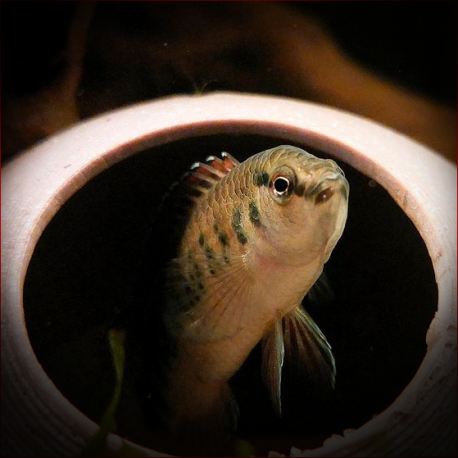More info
Datasheet
| Minimum Tank Size | 60 litres / 15.85 US gallons |
| Maximum Size | 6.0cm / 2.36inches |
| Temperature | 15°C / 59.00°F - 25°C / 77.00°F |
| Hardness | 1.01dgH / 18ppm - 5.04dgH / 90ppm |
| pH | 6.5-7.5 |
General Description
Badis ferrarisi, a member of the family Badidae, is an attractive fish with distinctive body patterning consisting of usually 11 short dark bars extending along its body. It is closely related to other Badis species and is arguably the most visually appealing among them, yet still poorly documented in the aquarium trade.
Aquarium Setup
For optimal care, B. ferrarisi should be housed in a well-structured aquarium setup with a sand or gravel substrate, water-worn rocks, and ample hiding places provided by driftwood, branches, and caves. Live plants such as Microsorum or Anubias can be added but are not necessary. Water conditions such as a pH of 6.5-7.5, hardness of 18-90ppm, and a temperature range of 15-25°C should be maintained (see table).
Behaviour
As solitary creatures, B. ferrarisi is not gregarious and can exhibit aggression towards rival males, especially in smaller tanks. It is essential to provide ample territory space and hiding spots to prevent aggressive behavior. When housed in a community tank, peaceful tankmates like Trigonostigma or Rasbora species are recommended. Extreme caution should be exercised when selecting tankmates to ensure compatibility.
Feeding and Diet
Being micropredators, B. ferrarisi feeds on small aquatic crustaceans, worms, insect larvae, and zooplankton. While they may not readily accept dried foods, offering small live or frozen fare such as Artemia or bloodworms is crucial to maintain their health and vibrant coloration. It is advised to avoid feeding them chironomid larvae or Tubifex to prevent obesity and disease susceptibility.
Reproduction & Dimorphism
Cave spawners with temporary pair bonds, B. ferrarisi males exhibit courtship behavior towards females. Spawning occurs in caves with the male guarding the eggs and fry. Females are smaller with duller patterning, while males develop extended finnage as they mature. Successful breeding can be achieved with a single pair or a group in a well-arranged tank setup.
Habitat and Distribution
Endemic to the Ayeyarwady River drainage in Myanmar, B. ferrarisi is typically found in slow-moving streams with marginal vegetation and sandy substrates. Recent collections have indicated their presence in specific regions near the Kalaymyo town within the Ayeyarwady River basin.

